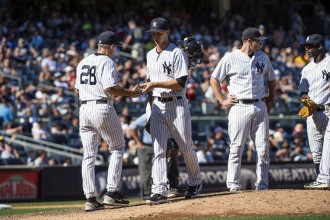The past month hasn’t been kind to the Yankees, with a combination of injuries and ineffectiveness causing the team to fall further out of first place in the AL East. The team has been dealt another blow in the sudden struggles of Chasen Shreve, who had been the team’s third best reliever. Things have gone off the rails for Shreve in his past seven outings, with his ERA ballooning from 1.95 to 2.67. Is Shreve just having an unlucky stretch, or is he broken?
End points are arbitrary, but August 30th seems to be the turning point for Shreve. Exploring the differences before the 30th and afterward turn up some alarming trends. While Shreve was clearly bound for some regression (an unsustainable .235 BABIP and 3.82 FIP), his ineffectiveness can be attributed to far more than that. What has plagued Shreve most has been his control. He has always been teetering on the line of wild, with a 4.71 BB/9 on the season, but he has an atrocious 9.95 BB/9 since August 30th. It’s unlikely that Shreve is dealing with an injury or fatigue that has lead to a lack of control, as all of his pitches have maintained consistent velocity and shape. There’s no clear reason for why he can’t seem to find the strike zone, but it’s likely Shreve’s biggest issue right now.
Another problem for Shreve is his splitter. Usually his best pitch, it’s been hit hard lately. Before August 30th, Shreve’s batting average against his splitter was .088. Since then it is .375. The reason behind this increase is that batters are seeing the splitter better: they are whiffing on the pitch 9.53 percent less since the end of August. At this point, Shreve’s splitter is not a weapon that hitters have to worry about. When a pitcher loses his feel on his best pitch, a whole lot can go wrong, as it has for Shreve.
Shreve’s fastball has also been destroyed of late (hitters are slugging .786 against it in September, .471 points more than before). Obviously, his loss of command has allowed batters to make hard contact more frequently. Also, Shreve had excellent results with his (relatively unremarkable) fastball in the past, thanks to the threat of his splitter. Without this splitter, hitters can sit on the fastball. We’re working with small sample sizes right now, but the splitter/fastball effect can be seen twice in the past two weeks. Against the Blue Jays on September 11th, Shreve gave up a home run to Russell Martin. He started with a fastball out of the zone, following it with a splitter that was nowhere close. After that, Shreve threw a fastball, which Martin was sitting on and pulled for a home run. Three days earlier, the same thing happened. Shreve buried a 1-0 splitter in the dirt to Chris Davis. Once again, the pitch was nowhere close, and on the next pitch, Davis turned on it for a game-spoiling home run. These are just two instances, but they serve as an example of what happens when Shreve doesn’t have his splitter working.
On Saturday, Brian Cashman acknowledged Shreve’s struggles, and said that the team “may need to call a different name until we can get him resuscitated.” While resuscitated is an odd term to use, Cashman is correct. Shreve’s issues won’t right themselves with better luck, it will take some something to click or mechanical changes before Shreve can be effective again. To answer my initial question, yes, Shreve is broken. Luckily, he can be fixed. But with a lack of trustworthy options behind the overused Betances and Miller, the new question is: When will Shreve be fixed?
(Photo: Gregory Fisher-USA Today Sports)

yes he is broken,but girardi is more broken(using your words) and will continue using him in key situation.a lot of guys go sower,but managers have the sense to stop using them,especially when you are fighting for a pennant and only approx.15 games left in the season.look at joes handling of drew and young they have gone bad,drew never was good for us.